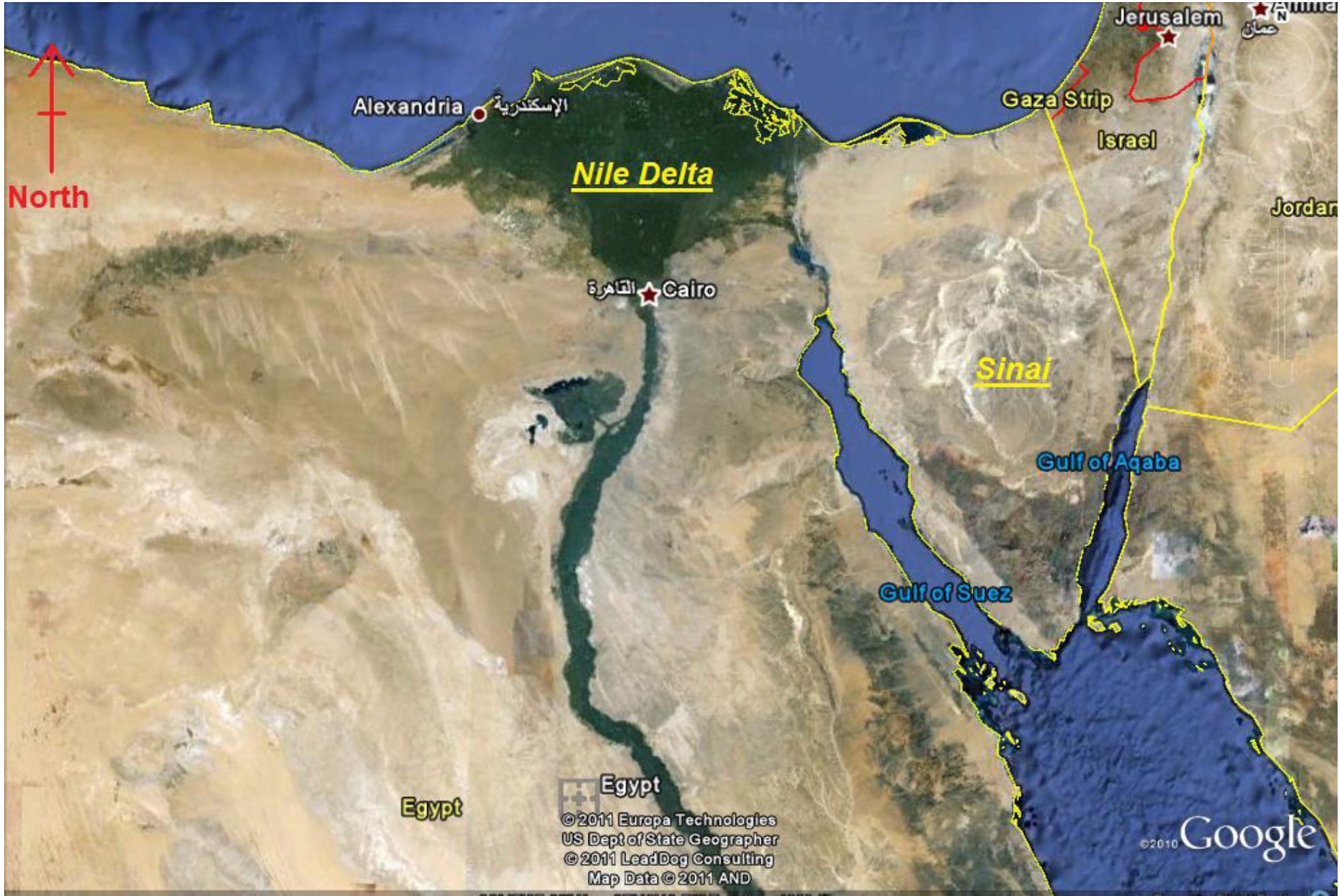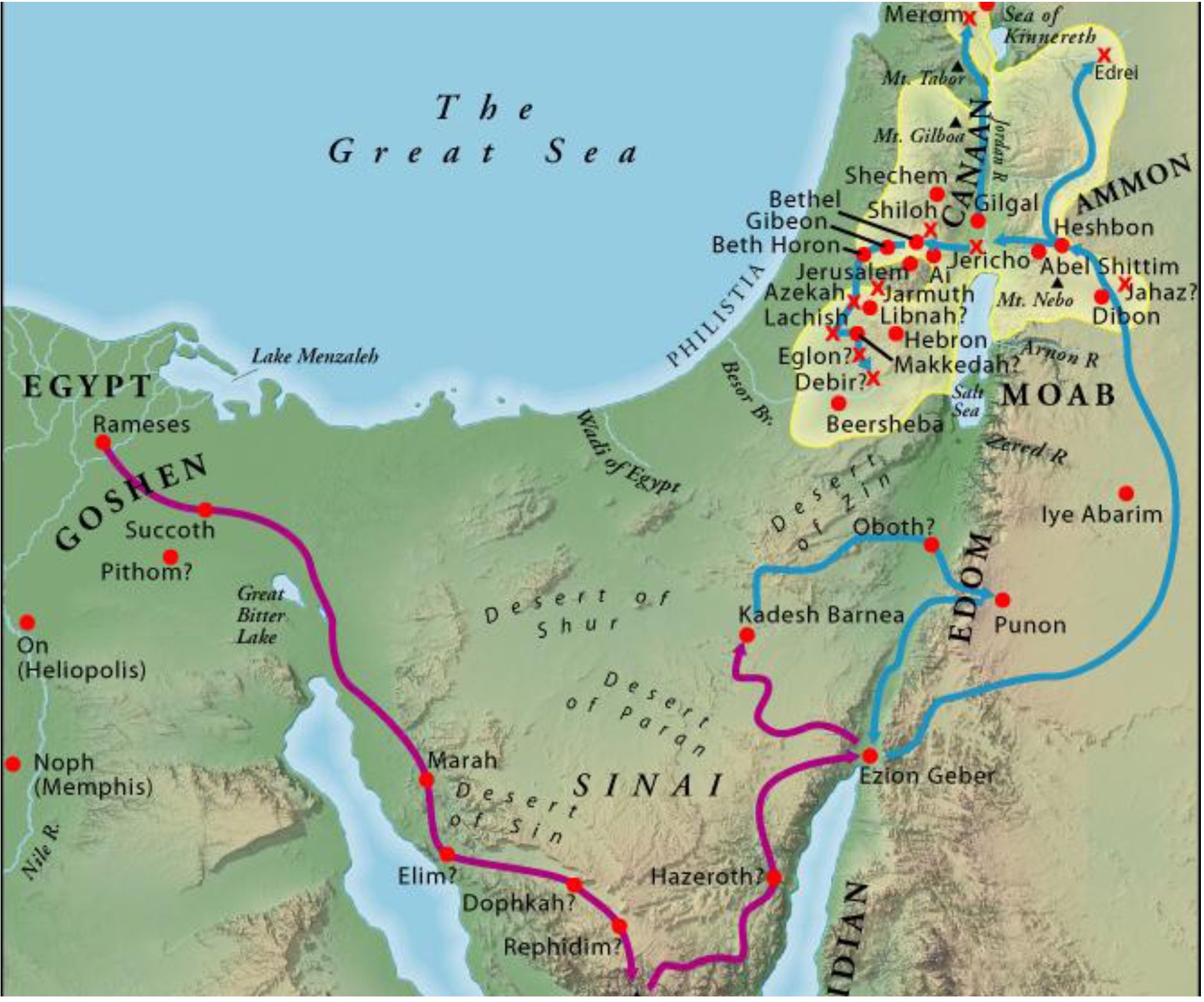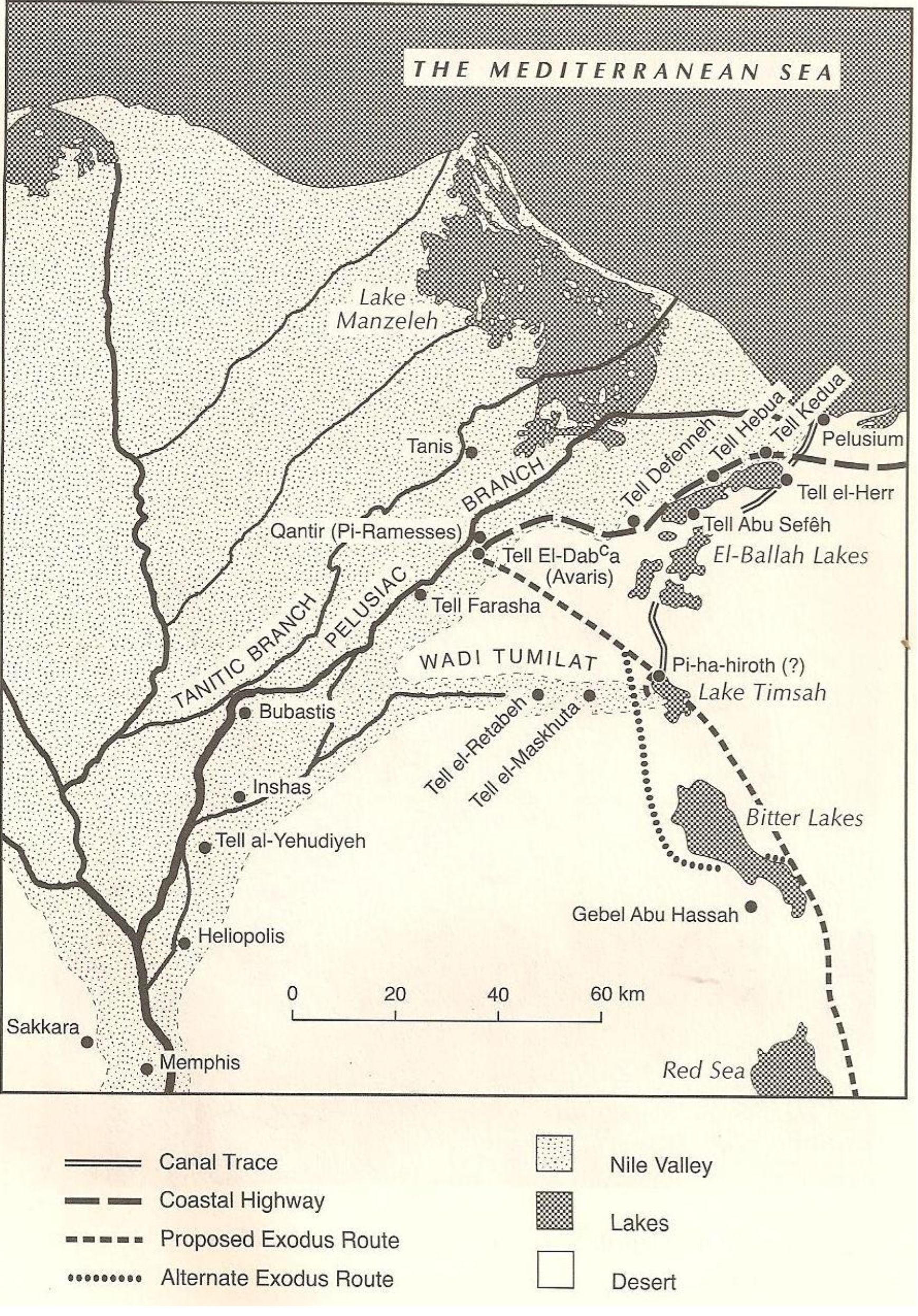Amenhotep IV, or Ankhenaton as he called himself, father of the ever-famous "King Tut", attempted to turn all of Egypt into monotheism during his reign. Egyptian art changed drastically during this time, as the Aton, a god of the solar disc, became the focus of all religious art representations with all other gods being purged of religious illustrations (Redford 1999: 57). Akhenaten also rejected the ancient royal residences of Memphis and Thebes, and built a new capitol, Akhetaten ("Horizon of the Sun") in Middle Egypt, where he could concentrate the entire economy of Egypt in the worship of his life. the only god (Redford 1999: 57). However, Akhetaten's monotheistic cult was not accepted by most Egyptians and collapsed with the end of his reign (Redford, 1999: 57).
Many scholars have attempted to establish a connection between the religion of Akhenaten and the religion of the Israelites, with some even suggesting that Moses was a protege of Akhenaten. However, the two religions had little in common besides being both monotheistic (Chavalas 2002). The god of Akhenaten was a solar deity associated with light and the sun, unlike the Hebrew god Yahweh. The name of the deity was not new and had few recognizable attributes (Chavalas, 2002). Moreover, there were many depictions of Aten, as opposed to the prohibitions against portraits of Yahweh. Moreover, there was no covenant relationship between the Egyptians and the Atenes, as there was with Israel and Yahweh (Chavalas 2002). Many scholars argue that the Hymn to Aten and Psalm 104 are strikingly similar, suggesting a dependence on Hebrew theology on the monotheism of Akhenaten. Although they do indeed have many similarities, this is mainly based on Egyptian literary influence, not on religious influence, as shown by the comparisons above (Chavalas 2002).
The Exodus Route
There are several different theories as to which way the Israelites took in their exodus from Egypt, but for the most part these theories can be classified as variations that fall into three separate categories: the Northern Route Theory, the Southern Route Theory and the Central (or Arabic) Route Theory. The itinerary of Israel's travels from Egypt to Mount Sinai is little more than a list of obscure names (Bible of Archaeological Study: 108). According to the Bible, we know that the Israelites moved from Ramses to Succoth (Exodus 12:37), and that "after they had left Succoth, they encamped in Etam at the edge of the wilderness" (Exodus 13:20). to proceed to Pi Hahiroth, located near Migdol, Baal Zephon and the sea (Exodus 14: 2). After that, the Israelites crossed the Red Sea (Exodus 14: 21-22), and wandered in the wilderness of Sur for three days (Exodus 15:22) before reaching Marah (Exodus 15:23) and Elim (Exodus 15:27). From here, they proceeded through the Desert of Sin, to Rephidim (Exodus 17: 1), and finally reached the region of Mount Sinai (Exodus 19: 1-2). As detailed as it may seem, scholars are not sure of most of these place names. Not to mention, there is confusion about where the Israelites crossed the Red Sea, as well as the identity of the sea itself (Bible of Archaeological Study: 108). In this section, I introduce each of the theories mentioned above and explain why each is plausible or not. and finally reached the region of Mount Sinai (Exodus 19: 1-2). As detailed as it may seem, scholars are not sure of most of these place names. Not to mention, there is confusion about where the Israelites crossed the Red Sea, as well as the identity of the sea itself (Bible of Archaeological Study: 108). In this section, I introduce each of the theories mentioned above and explain why each is plausible or not. and finally reached the region of Mount Sinai (Exodus 19: 1-2). As detailed as it may seem, scholars are not sure of most of these place names. Not to mention, there is confusion about where the Israelites crossed the Red Sea, as well as the identity of the sea itself (Bible of Archaeological Study: 108). In this section, I introduce each of the theories mentioned above and explain why each is plausible or not. I present each of the theories mentioned above and explain why each of them is plausible or not. and finally reached the region of Mount Sinai (Exodus 19: 1-2). As detailed as it may seem, scholars are not sure of most of these place names. Not to mention, there is confusion about where the Israelites crossed the Red Sea, as well as the identity of the sea itself (Bible of Archaeological Study: 108). In this section, I introduce each of the theories mentioned above and explain why each is plausible or not. I present each of the theories mentioned above and explain why each of them is plausible or not. and finally reached the region of Mount Sinai (Exodus 19: 1-2). As detailed as it may seem, scholars are not sure of most of these place names. Not to mention, there is confusion about where the Israelites crossed the Red Sea, as well as the identity of the sea itself (Bible of Archaeological Study: 108). In this section, I introduce each of the theories mentioned above and explain why each is plausible or not. there is confusion about where the Israelites crossed the Red Sea, as well as the identity of the sea itself (Bible of Archaeological Study: 108). In this section, I introduce each of the theories mentioned above and explain why each is plausible or not. there is confusion about where the Israelites crossed the Red Sea, as well as the identity of the sea itself (Bible of Archaeological Study: 108). In this section, I introduce each of the theories mentioned above and explain why each is plausible or not.
The most popular theory of the Exodus route is the Southern Route Theory (Figure A2). Most proponents of this theory suppose that Ramses is stationed in the generally accepted place of Qantir, located in the east of the Nile delta (Archaeological Study Bible: 109). From there, the Israelites would have made their first stop in Sucote, located at the eastern end of Wadi Tumilat, near the modern Tell el-Maskhuta (Bible of Archaeological Study: 109). Due to the translation of Pi Hahiroth as "channel mouth," this site was suggested by Hoffmeier to be located on the northern edge of Lake Timsah (Figure A3), where it would have joined the channel system of Egypt (Hoffmeier 1996: 169-171 ). ). Hence the Egyptian armies stationed on the highly fortified north-eastern border would have pursued the Israelites either through Lake Timsah or the northern tip of the Gulf of Suez, where the Egyptian army drowned. After crossing the Red Sea, the Israelites would have traveled to Mount Sinai, which in this scenario would probably be located in the modern Jebel Musa ("Moses Mountain") in southern Sinai (Bible of Archaeological Study: 109).
The Northern Route Theory suggests that the Israelites crossed Lake Sirbonis on the Mediterranean coast and that Mount Sinai was actually located in northern Sinai (Bible of Archaeological Study: 108). However, "When Pharaoh let the people go, God did not take them on the road through the Philistine country, although it was shorter. Because God said, "If they face war, they can change their minds and go back to Egypt '" (Exodus 13:17). Thus, this theory is not widely accepted because it has the Israelites taking a route that God specifically forbade. In addition, the Israelites would have to pass through the garrison of the highly fortified northeast of Egypt to do so.
The Theory of Central Route (or Arabic) is based on two assumptions: that Mount Sinai was actually located in Arabia , and that the only body of water clearly identified as the Red Sea , is the Gulf of Aqaba (Bible Archaeological Study: 112 ). Like the Southern Route Theory, this theory also has Qantir as Rameses and relates Sukkot to Tell el-Maskhuta, but later
2 The Hebrew word yam suf translates "Sea of Reed" (Hoffmeier 1996). The only other part of the Bible where yam suph is used to designate a specific place is in 1 Kings 9:26, where the term refers to the Gulf of Aqaba. However, some scholars have interpreted yam suf to refer to the Red Sea as a whole (Archaeological Study Bible: 110).
At this point, the theories are completely different (Archaeological Study Bible: 112). This theory neglects the fortifications in the Suez area because it assumes that the Egyptian quest did not begin until the Israelites were well inside the Sinai Peninsula (Bible of Archaeological Study: 112). This theory suggests that the Israelites would have followed Darb el-Hajj, a trade route linking Arabia to Egypt that follows a line almost straight from the northern Gulf of Suez to the northern tip of the Gulf of Aqaba (Archaeological Study Bible: 112 ). The next stop would have been Etham. There is a mountain at the northeastern tip of the Gulf of Aqaba, called Mount Itm (also written as Ithem or Yitm), which may be related to this site (Bible of Archaeological Study: 112). From here, the Israelites would have made a face and followed along the western side of the gulf to give the Egyptians the impression that the Israelites were "wandering the earth in confusion" (Exodus 14: 3), after which they would have crossed the Gulf of Aqaba . Because of the location of the intersection of the Gulf of Aqaba, this theory agrees very well with Humphreys' "wind deceleration" hypothesis. From here, the Israelites would have traveled along the eastern edge of the gulf to Mara, which could have been the oasis in modern al-Malha (Bible of Archaeological Study: 112). After that, they would have traveled to Elim, where there were "twelve springs and seventy palm trees" (Exodus 15:27), which could have been Ainuna, a place where similar conditions existed (Bible of Archaeological Study: 112). Eventually, the Israelites would have reached Mount Sinai, which, according to this theory, was probably the Mount Bedr (Archaeological Study Bible: 112) volcano. Although this theory offers a fascinating interpretation of the exodus itinerary, little serious archaeological work was done to support it (Archaeological Study Bible: 112).
CONCLUSIONS
We enter into this study by questioning whether biblical sources, specifically the Exodus account, are reliable stories when taken from a historical perspective, so let's take a moment to summarize what has been shown by this reading. First, it has been shown that there is a plethora of archaeological evidence supporting the notion of Semitic presence in Egypt, and it is plausible that the Israelites, who would have been a minority among their Canaanite contemporaries at this time, could have been among these Semitic Peoples. Second, it has been shown that Egyptian builders experienced working conditions similar to those recorded by the Israelites. Moreover, it was shown that the Hebrew god, Yahweh, was known to the Egyptians after the proposed date of the beginning of the Exodus. The Eastern Boundary Channel and excavations at Tell el-Borg revealed that Egypt had a heavily fortified eastern front after the expulsion of the Hyksos, which makes credible the decision of the Israelites to take a longer route from Egypt to Canaan and also provides a possible location for the biblical Pi Hahiroth. Natural explanations were also given for the plagues and miracles recorded in Exodus, showing that the story was not entirely "mythological," but nonetheless miraculous. This study also presented at least two plausible routes to the Exodus, based on the amalgamation of biblical place names, archaeological evidence, and similarities of modern places. which makes credible the decision of the Israelites to take a longer route from Egypt to Canaan and also provides a possible site for the biblical Pi Hahiroth. Natural explanations were also given for the plagues and miracles recorded in Exodus, showing that the story was not entirely "mythological," but nonetheless miraculous. This study also presented at least two plausible routes to the Exodus, based on the amalgamation of biblical place names, archaeological evidence, and similarities of modern places. which makes credible the decision of the Israelites to take a longer route from Egypt to Canaan and also provides a possible site for the biblical Pi Hahiroth. Natural explanations were also given for the plagues and miracles recorded in Exodus, showing that the story was not entirely "mythological," but nonetheless miraculous. This study also presented at least two plausible routes to the Exodus, based on the amalgamation of names of biblical places,
Thus having in mind the factors that determine that the Hebrews were in Egypt, the more chromosome characteristic is that the Hebrews were not Egyptians of African chromosomal characteristic, in fact has that the Hebrews went to the Egypt and from there they left. How and why such things happened can only be explained for the time being by biblical accounts.

Figure A1. Map of Egypt and Sinai (from Google Earth).

Figure A2. Southern Exodus Route and the Conquest of Canaan (from NIV Archaeological Study Bible).

Figure A3. Map of Southern Exodus Route showing Eastern Frontier Channel and Pi Hahiroth
(from Hoffmeier 1996)
Table 1. Chronology of Ancient Egypt (adapted from Encyclopedia of the Archeology of Ancient Egypt)
| PERIOD | DATES | DYNASTS |
| Paleolithic | 700,000 BP - 8,000 BP | N / A |
| Neolithic | 5200 BC - 4000 BC | N / A |
| Predynastic | 4000 BC - 3050 BC | Pre-dynastic dynasties |
| Early Dynastic | 3050 BC - 2686 BC | 1 - 2 |
| Old kingdom | 2686 BC - 2181 BC | 3 - 6 |
| First Intermediate Period | 2181 BC - 2055 BC | 7-11 |
| Middle Kingdom | 2055 BC - 1795 BC | 11-12 |
| Second Intermediate Period | 1795 BC - 1550 BC | 13 - 17 |
| New kingdom | 1550 BC - 1069 BC | 18 to 20 |
| Third Intermediate Period | 1069 BC-664 BC | 21-25 |
| Delayed period | 664 BC-332 BC | 26 -31 |
| Ptolemaic period | 332 BC - 32 BC | Ptolemaic dynasties I - IX |
| Roman Period | 31 BC - 312 AD | N / A |
| Coptic Period | 312 AD-639 | N / A |
Table 2. Ancient Syria-Palestine Chronology (adapted from Biblical Land Archeology)
| PERIOD | DATES | |
| Pre-Ceramic Neolithic A | 8500 BC | - 7500 BC |
| Pre-Ceramic Neolithic B | 7500 BC | 6000 BC |
| Neolithic Ceramics A | 6000 BC | - 5000 BC |
| Ceramics Neolithic B | 5000 BC | 4300 BC |
| Chalcolithic | 4300 BC | 3300 BC |
| Home Bronze I | 3300 BC | 3050 BC |
| Early Bronze II - III | 3050 BC | - 2300 BC |
| Home Bronze IV / Medium Bronze I | 2300 BC | 2000 BC |
| Middle Bronze IIA | 2000 BC | 1750 BC |
| Middle Bronze IIB - C | 1750 BC | 1550 BC |
| Late Bronze I | 1550 BC | 1400 BC |
| Late Bronze IIA - B | 1400 BC | - 1200 BC |
| Iron IA | 1200 BC | 1150 BC |
| Iron IB | 1150 BC | - 1000 BC |
| IIA of iron | 1000 BC | - 925 BC |
| Iron IIB | 925 BC | - 720 BC |
| IIC of iron | 720 BC | 586 BC |
BIBLIOGRAPHY
Aling, Charles
2009 The name Yahweh in Egyptian hieroglyphic texts. In Artifax, edited by Charles Aling and Clyde Billington. Accessed online.
http://biblearchaeology.org/post/2010/03/08/The-Name-Yahweh-in-Egyptian-
Hieroglyphic texts.aspx
Bietak, Manfred
Overview of the Second Intermediate Period of 1999. In Encyclopedia of the Archeology of Ancient Egypt, edited by Kathryn A. Bard and Steven Blake Shubert, pp. 54-56. Routledge, New York.
Bietak, Manfred
1999 Tell ed-Dab'a, Second Intermediate Period. In Encyclopedia of the Archeology of Ancient Egypt, edited by Kathryn A. Bard and Steven Blake Shubert, pp. 778-782. Routledge, New York.
Chavalas, Mark W.
2002 Moses. In Old Testament Dictionary: Pentateuch, edited by D. Alexander and D. Baker, pp. 570-579. IV Press, Downers Grove.
Duty, William G.
1999 Israelites. In Encyclopedia of the Archeology of Ancient Egypt, edited by Kathryn A. Bard and Steven Blake Shubert, pp. 54-56. Routledge, New York.
Hello, William W.
1990 The Limits of Skepticism. Journal of the American Eastern Society 110: 187-199. Hoffmeier, James K.
1996 Israel in Egypt: Evidence of the authenticity of the Exodus tradition. Oxford University Press, New York.
Hoffmeier, James K.
2004 Tell el-Borg about the eastern border of Egypt: a preliminary report on the seasons of 2002 and 2004. In the journal of the American Research Center in Egypt 41: 85-111.
Hoffmeier, James K.
2005 Ancient Israel on Sinai: Evidence of the authenticity of the desert tradition. Oxford University Press, New York.
Humphreys, Colin J.
2004 The Miracles of the Exodus: A Scientific Discovery of the Extraordinary Natural Causes of Biblical Stories. HarperCollins, San Francisco.
Josephus, Flávio
Against Apionem, Book I, Chapter 14, Parts 73-92. In 1940 Manetho, translated by WG Waddell, pp. 76-91. Harvard University Press, London.
Mazar, Amihai
2009 Earth Archeology of the Bible. Yale University Press, New Haven.
Redford, Donald B.
Overview of the New Kingdom of 1999. In Encyclopedia of the Archeology of Ancient Egypt, edited by Kathryn A. Bard and Steven Blake Shubert, pp. 57-61. Routledge, New York.
2005 NIV Archaeological Study of the Bible. Zondervan, Grand Rapids, Michigan.
Bless_Jonathon_Thesis.pdf

